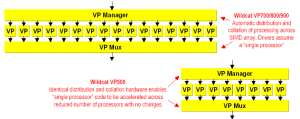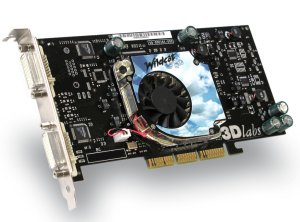
The new Wildcat VP560 represents a slightly more interesting development. As mentioned before the Wildcat VP560 is not using the Wildcat VP760-970 core, P10, but still retains all of the P10's programmability. The VP560 is actually using a chip codenamed P9, based on the same architecture as P10.
P9 represents a success in the scaleable nature of the P10 architecture. As we know the P10 architecture features highly parallel arrays throughout the the Vertex and Pixel pipelines and, the theory being, should higher or lower power versions of the architecture be required then arrays could be widened or shortened with relative ease. With P9 3Dlabs aimed for a lower end, more cost effective part and hence took the P10 architecture and cut back on some of the arrays.
Because of the scaleable nature of using highly parallel pipelines the development and bring-up of P9 was a fairly fast process. P9 started development once P10 was complete and is being brought to the market just 3 months after P10's release. In fact, during a tour of the 3Dlabs offices at the press launch of Wildcat VP last June 3Dlabs showed us the very first version of P9, which had only come back from the fab two days before. Once recieving the P9 silicon, 3Dlabs had managed to bring the chip up in about 2 hours, and by the time we saw it just two days later it was operating in a PC and even running the nature test in 3DMark2001 -- not bad going.
Being based off the P10 architecture means that P9 also carries through all the features P10 also did, such as its highly programmable pipeline and Virtual Memory management system.
The Wildcat VP560 board features dual DVI-I connectors for multiple flat panel display support, 64MB of DDR RAM and is expected to retail around the $250 mark. Being based off the P10 architecture means that the card is already fully compliant with DirectX8.1, and has Wildcat VP unified DX8.1 drivers as well as OpenGL 1.3 and prototype OpenGL 2.0. The level of functionality in the Vertex processor array means that this is already a superset of DX9 vertex shader VS2.0 specification, however the lack of floating point pixel pipelines means that it will not attain full DX9 pixel shader compliance.
This is how Wildcat VP560 stacks up in the VP range:
| Product | Wildcat VP970 | Wildcat VP870 | Wildcat VP760 | Wildcat VP560 |
| Memory | 128 MB 256-bit DDR | 128 MB 256-bit DDR | 64 MB 256-bit DDR | 64 MB 128-bit DDR |
| Displays | Independent Dual-Head VGA+DVI-I | Independent Dual-Head VGA+DVI-I | Independent Dual-Head VGA+DVI-I | Independent Dual-Head DVI-I+DVI-I |
| Performance | 255M Vertices/Sec 42G AA Samples/Sec |
188M Vertices/sec 35G AA Samples/Sec |
165M Vertices/Sec 23G AA Samples/Sec |
100M Vertices/Sec 18G AA Samples/Sec |
| Value | Ultimate Visual Processing Performance | Powerful, Versatile Productivity | Affordable, CAD-optimized Performance | Entry-level Dual Display Workstation Graphics |
| Segment | CAD DCC Simulation |
CAD DCC Simulation |
CAD Low-end DCC |
CAD Web Graphics Desktop Publishing |
| ESP (US$) | $1,199 | $599 | $449 | $249 |
Wildcat VP560 also holds one other rather surprising element...


